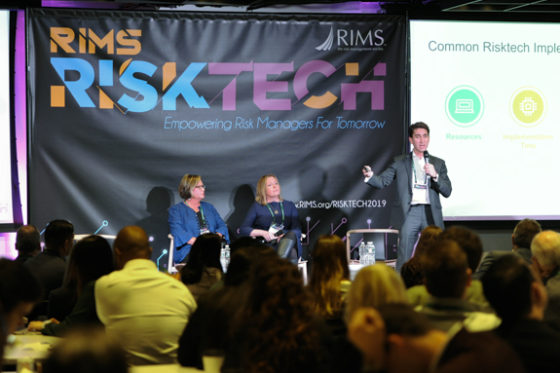
This week’s inaugural RIMS Risktech Forum highlighted many of the ways technology is changing how risk professionals approach their work, and the advantages of embracing new innovations. During the “What Can Risktech Do for Me?” panel, Mike Poulos of Marsh LLC, Jen Thorson of data analytics firm Modjoul, and Susan Shemanski, vice president of risk management for Adecco Employment Services discussed one of the practical applications of risktech—wearable workplace technology—to prevent injuries and unsafe behavior, protect workers, and mitigate liability for employers. In the course of normal business for many companies, employees in physically demanding jobs can twist, reach and otherwise strain their bodies in different ways that can lead to both immediate and long-term injuries.
New technology offers a way to mitigate these risks.
After an overview of the general field of wearable risktech devices and their benefits, the panel discussed a real case of how a company implemented a program using belts that would track and collect data on employees’ movements, including twisting and reaching. The result, they said, was discovering multiple literal pain points for their employees and their company, and it may change how risk managers can root out and address risks like healthcare and insurance costs, employee health, morale and attrition, and even equipment costs.
For example, the panelists noted, one employee experienced pain when reaching bins on a bottom shelf as part of her work and even repurposed one of the bins as a stool for more comfort.
Another, whose job consisted of labeling packages, had to stretch to reach the label printer, aggravating their back in the process.
The belts provided data showing these strains, and the company adjusted the employees’ work spaces to alleviate them. After gathering and analyzing the data from the belts, the company hired an ergonomist and conducted employee training to reduce unsafe conduct, even using the data to produce a new training video for incoming employees.
The panelists stressed communication as an essential part of the adoption process, and noted the importance of addressing employee concerns—including whether the belts would collect blood alcohol level or heart rate (no to both)—before implementing the program.
To preempt privacy concerns and protect employees’ personal information, the company also anonymized the data the belts produced.
The benefits for companies from using this type of risktech are tangible and significant. Making work less dangerous for employees in physical jobs and reducing accidents and injuries can mean happier and healthier workers. This, in turn, can also positively affect productivity and attrition. Additionally, preventing workplace injuries can reduce healthcare costs, and companies can even sometimes use the data from wearable risktech devices to secure lower rates from their insurers.
As the panelists noted, in a tight hiring market, businesses may have to hire less experienced workers for physically demanding jobs, and monitoring physical movements can also help identify which employees may be doing dangerous things and need additional training. For example, ensuring that a relatively inexperienced forklift operator is not performing unsafe physical movements can prevent potentially catastrophic accidents that hurt the employee, the equipment, the company’s bottom line, and even its reputation.
Similarly, other panels at the forum showed how risk managers can use technology to address the risks their companies face, including utilizing artificial intelligence and machine learning, blockchain technology, and other innovative ways to harness data. For more information on how insurers and risk managers are using blockchain to change how they approach risk, check out the recent Risk Management articles “Can Blockchain Improve Insurance?” and “Strengthening the Links: How Blockchain Can Help Manage Supply Chain Risk.”

